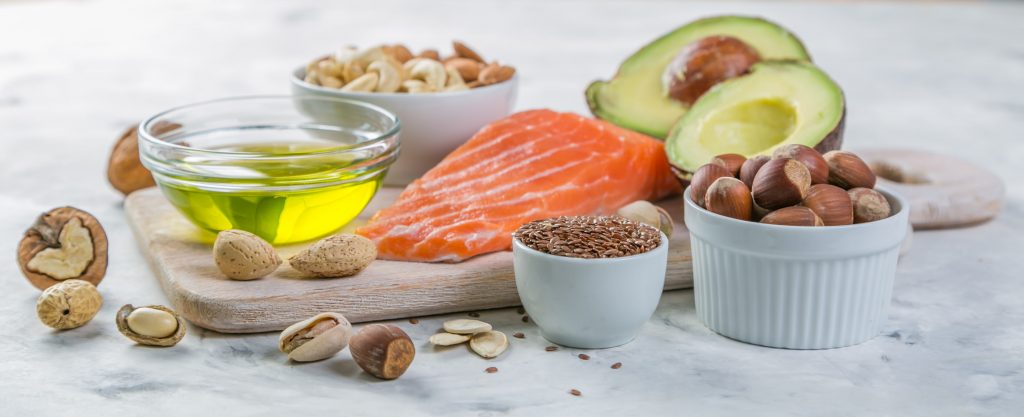Obesity has become a global phenomenon that is more and more present even in less developed countries. Overweight is an illness that is caused by multiple factors, and it requires a holistic approach. Gut microbiota is also important for a balanced body weight because it does not affect the usage of energy from food, fat metabolism, appetite, inflammatory processes, and hormonal functions. The change in the composition of the gut microbiota can be the cause, but also a consequence of being overweight.
What is gut microbiota?
People have been co-existing with bacteria and other microorganisms from the very beginning. Gut microbiota is a sort of a “hidden organ” whose composition and importance for the people’s health have been recognized only in the past few years.
Gut microbiota contains 100 times more genetic record than the human one and it is composed of bacteria, viruses, archei and yeast. Such high ratio leaves us wondering who is actually controlling whom here. However, a man and a microbiome need to live together because, in principle, they cannot survive without each other.
A human being provides the microbes with a life space, security, and food. On the other hand, the microbiota plays an important role in maintaining homeostasis, including maintenance of appropriate body weight, participation in many body processes, from digestion, energy regulation, immune system modulation, vitamin synthesis, protection from pathogenic bacteria and foreign bodies.
As long as the gut microbiota is balanced, it has an excellent effect on people’s health, but when it is destroyed, it can cause many chronic diseases (diabetes, autism, depression, irritable bowel syndrome…).
The biggest number of bacteria is in the large intestine because the conditions for the survival of the bacteria in the small intestine are quite unfavorable due to the increased exposure to digestive enzymes, stomach acid and bile salts. The gut microbiota is composed of 6 phyla – the bacteria from the Firmicutes phylum (60%) and Bacteroidetes phylum (20%) being the dominant ones. Together they represent more than 80% of species of bacteria and they have a huge impact on people’s health.
The ratio between the Firmicutes and Bacteroidetes bacteria has changed in overweight people compared to thin people.
What affects the gut microbiota?
The gut microbiota is extremely dynamic and flexible, and it reacts to many environmental factors. Accordingly, the composition and diversity of the gut microbiota is constantly changing from the person’s birth.
The most important period are the first years of life. In this period the mother has the most important impact on the establishment of the baby’s microbiome. The mode of birth (vaginal delivery, Caesarean section), feeding in the first months of life (breastfeeding, feeding with milk formula) and family surroundings are the foundation of the child’s microbiota.
When a child starts eating other kinds of food, there are again drastic changes, and the microbiota becomes more diverse. When a child is around 2 and a half years old, it becomes similar to the gut microbiota in adults.
Even though a microbiota becomes more stable when it reaches maturity, many different factors affect its diversity and composition. Its development is influenced by the hygienic conditions, our surroundings, stress, alcohol consumption, circadian cycle, age, and the genetic basis. A microbiota also goes through a lot of changes if we use medications, especially antibiotics and drugs that inhibit gastric acid.
However, from all the factors that affect the microbiota, the biggest impact has the nutrition. Highly processed food high in saturated fats and sugar and with a minimal quantity of fiber has a negative impact on the ratio of Firmicutes/Bacteroidetes bacteria. On the other hand, the food that is based on the Mediterranean diet maintains a good balance between the bad and useful bacteria.
The most important factors that have an impact on obesity
It’s a fact that obesity is caused by a long-term imbalance between the energy intake and consumption. There is also a simple equation for losing extra body fat: energy expenditure should exceed energy intake. Even though it seems simple, we can see on the example of people who want to lose excess weight that it’s not that easy.
Body weight is being regulated through complex hormonal, neural and metabolic mechanisms that affect the energy intake and consumption.
Intake of too much energy is mostly a consequence of the consumption of highly processed food that is extremely rich in energy because it contains a lot of saturated fats and sugar. By intaking such food into our body, it is very easy to exceed our daily energy needs and start storing the excess energy in our fat tissue. At the same time, we are negatively impacting many other body processes, such as starting a chronic inflammation.
This type of a diet also causes changes in the composition of the gut microbiota and it reduces its diversity, which is extremely important for the person’s health and body weight because the gut microbiota significantly impacts the metabolism, appetite, bile acid metabolism, hormonal and immune system.

The impact of the gut microbiota on body weight
The gut microbiota has a direct impact on the digestion, absorption, and metabolism of food, and it can potentially have an impact on weight gain through different mechanisms.
1. The gut microbiota has a significant impact on the energy intake
The bacteria in the digestive tract are responsible for the energy intake because they participate in the digestion of food which is normally indigestible for a human. That way they enable the access to the energy sources which would otherwise be inaccessible, and which would be eliminated from the body together with the feces.
Overweight people have an altered composition of the gut microbiota. Their microbiota is less rich and diverse, and the ratio between the bacteria from Firmicutes/Bacteroidetes phyla tends to lean towards the bacteria from the Firmicutes phylum. It is well known that the bacteria from the Firmicutes phylum are more efficient in the breakdown of the carbohydrates which we find indigestible and turning them into short-chain fatty acids that can be absorbed.
Western diet, which is rich in saturated fats and sugar and poor in fiber, creates a friendly environment for the bacteria from the Firmicutes phylum and leads to the spread of primarily those bacteria that effectively metabolize carbohydrates and therefore enable bigger consumption of energy from the consumed food. However, this additional energy will be stored in fat deposits if it is not spent.
Short-chain fatty acids (butyrate, propionate, and acetate) develop as a by-product of the fermentation of fibers that are indigestible for a human being, and they can later serve as a kind of available fuel for cell processes in different organs. For example, gut cells receive 60 to 70% of their energy from the short-chain fatty acids. However, unspent short-chain fatty acids are being transferred to the bloodstream. This way, a person should get no less than 10% of the daily energy needs.
However, different short-chain fatty acids also have different metabolic roles. While the butyrate is the primary energy source for the gut cells, acetate and propionate are used in producing fats, cholesterol and gluconeogenesis, a process of making glucose.
Still, not everything is as simple as it seems at first. On the other hand, short-chain fatty acids have huge benefits and positive effects on the body weight. For example, acetate crosses the blood-brain barrier, affects the hypothalamus, and suppresses appetite, and butyrate inhibits the activity of the appetite stimulating neurons.
An increase in body fat is not just a result of a better usage of the energy from food, but it is also based on microbial genetics, because as much as 75% of microbial genes that are associated with obesity belong to the Action Bacteria bacteria, and 25% to the Firmicutes bacteria. On the other hand, 42% of the genes associated with slenderness belong to the Bacteroidetes bacteria.

2. The gut microbiota participates in bile acid metabolism
The connection between the bile acids and gut microbiota is two-way. Besides being critical for the effective fat digestion, bile acids also play a role in the regulation of the gut microbiota. Bile acids have an antimicrobic effect, they damage the cell walls and prevent the growth of bacteria. A diet that is based on a high intake of foodstuffs of animal origin increases the number of microorganisms that are resistant to bile acids, which leads to the disruption of the gut microbiota.
On the other hand, gut bacteria can metabolize primary bile acids that are made from the cholesterol in the liver into secondary bile acids. Therefore, the gut microbiota has an effect on the metabolism of fat and cholesterol balance.
3. A disturbed gut microbiota can lead to a systemic inflammation
Obesity is connected to the low-grade chronic inflammation which can lead to insulin resistance and several metabolic diseases (type 2 diabetes, cardiovascular disease, non-alcoholic fatty liver…). The key link between the inflammation and obesity is a disturbed gut microbiota which helps increase the intestinal permeability. One of the triggers of the systemic inflammation that can be recognized in obese people are endotoxins, lipopolysaccharides, which are a component part of the cell membranes of some bacteria.
A diet rich in fats and sugar can lead to a disturbed gut microbiota which is dominated by the bacteria that are a rich source of lipopolysaccharides and other endotoxins. On the other hand, such diet also endangers the cell wall permeability.
An increased intestinal permeability facilitates the entry of higher levels of lipopolysaccharides into the bloodstream. After entering the bloodstream, they increase the inflammatory processes, stimulate fat build-up, hyperglycemia, fatty liver, and cause insulin resistance, and they are generally related to the occurrence of metabolic diseases.
On the other hand, there are bacterial cells (e.g. Bifidobacteria, Akkermansia Muciniphila) that help in stabilization of the cell wall, reduction of systemic inflammation, insulin resistance and regulation of overweight.

4. The gut microbiota affects the appetite
The gut and the brain are tightly connected. The communication between them is two-way through the autonomous nervous system and endocrine system (hormones).
Different organs in the body (stomach, pancreas, intestines, and adipose tissue) release hormones that work by stimulating or suppressing appetite. Hormones are signal molecules which transfer the information about the body condition to the brain. Appetite is controlled through the central nervous system (hypothalamus), which reacts to the signals of the stomach and intestine hormone, and the signals coming from the adipose tissue.
With its composition and metabolites that are produced during the fermentation, the gut microbiota stimulates the release of hormones and neurotransmitters and has an impact on which and how many of those hormones are going to be synthesized. This is how microbiota affects the sense of hunger or satiety. Leptin and ghrelin are hormones that significantly affect the energy balance.
Besides the basic function of storing energy, adipose tissue also has a function of secreting hormones, such as leptin. Leptin is a hormone that helps in the regulation of energy balance on a long-term basis and transfers information about the status of the energy stores in the form of adipose tissue to the brain. When those stores are high, it inhibits the food intake and stimulates energy expenditure.
On the other hand, ghrelin is a hormone that acts on short-term basis and gets released at the time when we do not eat. It is included in the processes of the energy balance, as well as hedonic mechanisms that affect the regulation of appetite. Ghrelin is released in the stomach, it is activated by the vagus nerve or is being transferred to the brain through the bloodstream, where it crosses the blood-brain barrier and transfers the hunger signals to the brain which stimulates the food intake.
How can the balance of the gut microbiota be re-established?
The gut microbiota is extremely adaptable and sensitive. If we change our diet, the change of the microbial composition becomes evident within the first 24 hours and is finally stabilized within 10 days.
We can influence the composition of the gut microbiota by appropriate basic interventions to our diet, and we should pay special attention to the intake of probiotic and prebiotic food.
The first step that needs to be taken is to reduce the intake of highly processed food and food rich in saturated fats and sugar, because such food is harmful for the gut microbiota.
We should base our diet mostly on foodstuffs of plant origin (healthy carbohydrates, legumes, nuts, seeds, fruit, and vegetables), which should be as diverse as possible.
Include some of the following nutrients that support useful microbiota in your diet:
- When we talk about the gut microbiota, we cannot skip fibers because they are the most important nutrient for the useful gut microbes, and therefore for the gut health in general. The foundation of our health is to have a well-functioning gut.
Even a small and short-term increase in fiber intake causes great changes in the gut microbiota. The goal is to intake at least 30 g of fibers per day, which is around 5 portions of fruit and vegetables per day (2 portions of fruit and 3 portions of vegetables). Fibers are present in all sources of healthy plant-based food (e.g. fruit, vegetables, legumes…).

- Polyphenols and flavonoids can be found in fruit and vegetables, green tea, coffee, legumes, nuts, and seeds. They have antioxidative, anti-inflammatory, neuroprotective, and anticancer properties. These compounds are being slowly and badly absorbed, so they stay in the gut longer so we can take advantage of all their beneficial effects on the gut microbiota.
- Omega 3 fatty acids are essential fatty acids which cannot be produced by the human body itself, so we need to take them in through food. Besides their other important roles in the body (e.g. cardiovascular health), we cannot disregard their positive effect on the gut microbiota because they directly modulate the diversity of the microbiota, reduce the inflammatory processes that have occurred due to lipopolysaccharides and have a beneficial effect on the production of short-chain fatty acids.
Omega 3 fatty acids can be found in animal sources (mostly in salmon, sardines, mackerel) and the foodstuffs of plant origin (walnuts, flax, and chia seeds), but they come in an inactive form omega 3 and they need to be additionally converted and this conversion is only from 0,5 to 5 %.

- Probiotics and prebiotics are food components that deserve all the glory they get. Probiotics are live microorganisms that have a beneficial effect on our health. They can be found in fermented food (yogurts, kefir, sauerkraut and sour turnip, miso, fermented vegetables…) or they can be found as food supplements. When they are consumed, they enter directly into the digestive tract and therefore help restore the destroyed gut microbiota.
Prebiotics are, however, food for gut microbiota. They modulate the pH value of the gut which is not suitable for the development of pathogenic bacteria and help in regulation of appetite. What’s the difference between fibers and prebiotics? All the prebiotics are fibers, while not all the fibers can be prebiotics. For the fibers to also be prebiotics, they need to have two properties. The first one is that the gut microbiota can be used and fermented, and the second one is that it also has to scientifically prove the beneficial (health) effects.
The main prebiotics are inulin, fructo-oligosaccharides, galacto-oligosaccharides which can be found in fruit (apricots, nectarines, rosehip, plums, figs, dates…), vegetables (artichokes, beet, garlic, onion, Brussels sprouts) and nuts and legumes.
Reduced diversity of the gut microbiota can be seen in overweight people, which is also connected to dyslipidemia (elevated triglycerides and cholesterol), disrupted blood sugar control and elevated low-grade inflammation. Diet intervention, with a smaller energy intake and with the support of the gut microbiota, is an excellent strategy for losing weight. Since the gut microbiota is flexible and adaptable, it can be restored with an appropriate support through diet and by adapting the way of life.
Beneficial diet for the microbiota, which is also geographically close to us, is a Mediterranean diet. It is based on a diverse plant base, large consummation of extra-virgin olive oil, omega 3 fatty acids, and a low share of animal proteins, saturated fats and sugar.
SOURCES AND LITERATURE
- Cornejo-Pareja, I., Muñoz-Garach, A., Clemente-Postigo, M. et al. Importance of gut microbiota in obesity. Eur J Clin Nutr 72, 26–37 (2019). https://doi.org/10.1038/s41430-018-0306-8
- Crovesy L, Masterson D, Rosado EL. Profile of the gut microbiota of adults with obesity: a systematic review. Eur J Clin Nutr. 2020 Sep;74(9):1251-1262. doi: 10.1038/s41430-020-0607-6. Epub 2020 Mar 30. PMID: 32231226.
- Muscogiuri, G., Cantone, E., Cassarano, S. et al. Gut microbiota: a new path to treat obesity. Int J Obes Supp 9, 10–19 (2019). https://doi.org/10.1038/s41367-019-0011-7
- Karina Al-Assal, Ana Cristina Martinez, Raquel Susana Torrinhas, Camila Cardinelli, Dan Waitzberg, Gut microbiota and obesity, Clinical Nutrition Experimental, Volume 20, 2018, Pages 60-64, ISSN 2352-9393, https://doi.org/10.1016/j.yclnex.2018.03.001.
- Yawei Fu, Yadong Wang, Hu Gao, DongHua Li, RuiRui Jiang, Lingrui Ge, Chao Tong, Kang Xu, “Associations among Dietary Omega-3 Polyunsaturated Fatty Acids, the Gut Microbiota, and Intestinal Immunity”, Mediators of Inflammation, vol. 2021, Article ID 8879227, 11 pages, 2021. https://doi.org/10.1155/2021/8879227
- Beam A, Clinger E, Hao L. Effect of Diet and Dietary Components on the Composition of the Gut Microbiota. Nutrients. 2021;13(8):2795. Published 2021 Aug 15. doi:10.3390/nu13082795
- Green M, Arora K, Prakash S. Microbial Medicine: Prebiotic and Probiotic Functional Foods to Target Obesity and Metabolic Syndrome. Int J Mol Sci. 2020;21(8):2890. Published 2020 Apr 21. doi:10.3390/ijms21082890
- Leeuwendaal NK, Cryan JF, Schellekens H. Gut peptides and the microbiome: focus on ghrelin. Curr Opin Endocrinol Diabetes Obes. 2021 Apr 1;28(2):243-252. doi: 10.1097/MED.0000000000000616. PMID: 33481425; PMCID: PMC7924980.
- Davis CD. The Gut Microbiome and Its Role in Obesity. Nutr Today. 2016;51(4):167-174. doi:10.1097/NT.0000000000000167
Choose chapter:






